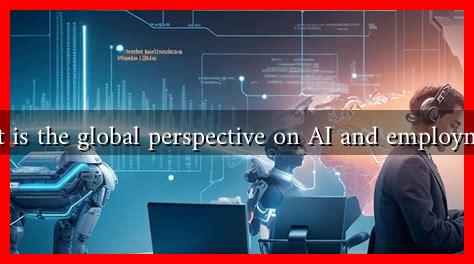-
Table of Contents
What is the Global Perspective on AI and Employment?
Artificial Intelligence (AI) is rapidly transforming industries worldwide, reshaping the landscape of employment in ways that are both promising and challenging. As AI technologies advance, they bring forth a myriad of opportunities for efficiency and innovation, but they also raise concerns about job displacement and the future of work. This article explores the global perspective on AI and employment, examining its implications, challenges, and potential solutions.
The Dual Nature of AI in Employment
AI’s impact on employment can be viewed through two lenses: job creation and job displacement. While some sectors experience growth due to AI, others face significant challenges.
Job Creation
AI has the potential to create new job opportunities in various fields. Some of the areas where AI is fostering job growth include:
- AI Development and Maintenance: As companies adopt AI technologies, there is a growing demand for skilled professionals who can develop, implement, and maintain these systems.
- Data Analysis: The rise of AI has led to an increased need for data scientists and analysts who can interpret the vast amounts of data generated by AI systems.
- AI Ethics and Governance: With the ethical implications of AI becoming more prominent, roles focused on AI ethics, policy-making, and governance are emerging.
According to a report by the World Economic Forum, it is estimated that AI could create 97 million new jobs by 2025, particularly in sectors like healthcare, technology, and renewable energy.
Job Displacement
Conversely, AI also poses a threat to certain job categories, particularly those involving repetitive tasks. Some sectors facing significant job displacement include:
- Manufacturing: Automation and AI technologies are increasingly replacing manual labor in factories, leading to job losses.
- Retail: The rise of e-commerce and AI-driven customer service solutions is reducing the need for traditional retail jobs.
- Transportation: The development of autonomous vehicles threatens jobs in driving and logistics.
A study by McKinsey Global Institute estimates that up to 375 million workers globally may need to switch occupational categories by 2030 due to automation and AI advancements.
Regional Perspectives on AI and Employment
The impact of AI on employment varies significantly across different regions of the world. Here are some notable examples:
North America
In North America, particularly the United States, the tech industry is at the forefront of AI adoption. Companies like Google and Amazon are leveraging AI to enhance productivity, leading to job creation in tech-related fields. However, traditional sectors such as manufacturing are experiencing job losses due to automation.
Europe
Europe is taking a more cautious approach to AI, focusing on ethical considerations and regulatory frameworks. The European Union has proposed regulations to ensure that AI technologies are developed responsibly, which may slow down the pace of adoption but aims to protect jobs and workers’ rights.
Asia
In Asia, countries like China are aggressively investing in AI, with the government aiming to become a global leader in AI technology by 2030. This has led to significant job creation in tech sectors, but also raises concerns about job displacement in traditional industries.
Preparing for the Future of Work
To navigate the challenges posed by AI, it is crucial for governments, businesses, and individuals to take proactive measures. Some strategies include:
- Reskilling and Upskilling: Investing in education and training programs to equip workers with the skills needed for emerging job roles.
- Policy Development: Governments should create policies that support workers affected by AI, including unemployment benefits and job transition programs.
- Promoting Lifelong Learning: Encouraging a culture of continuous learning to help workers adapt to changing job requirements.
Conclusion
The global perspective on AI and employment reveals a complex landscape characterized by both opportunities and challenges. While AI has the potential to create millions of new jobs, it also threatens to displace many existing roles. As we move forward, it is essential for stakeholders to collaborate in developing strategies that harness the benefits of AI while mitigating its adverse effects. By investing in education, reskilling, and ethical governance, we can pave the way for a future where AI and human workers coexist harmoniously.
For further insights on the impact of AI on employment, you can explore resources from the World Economic Forum and McKinsey & Company.

